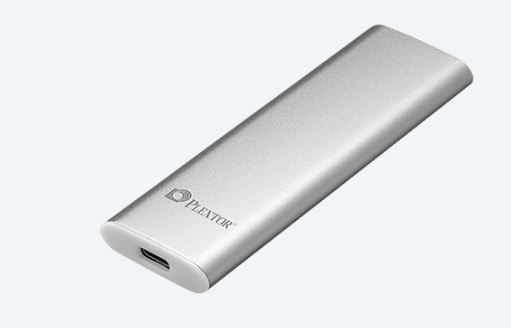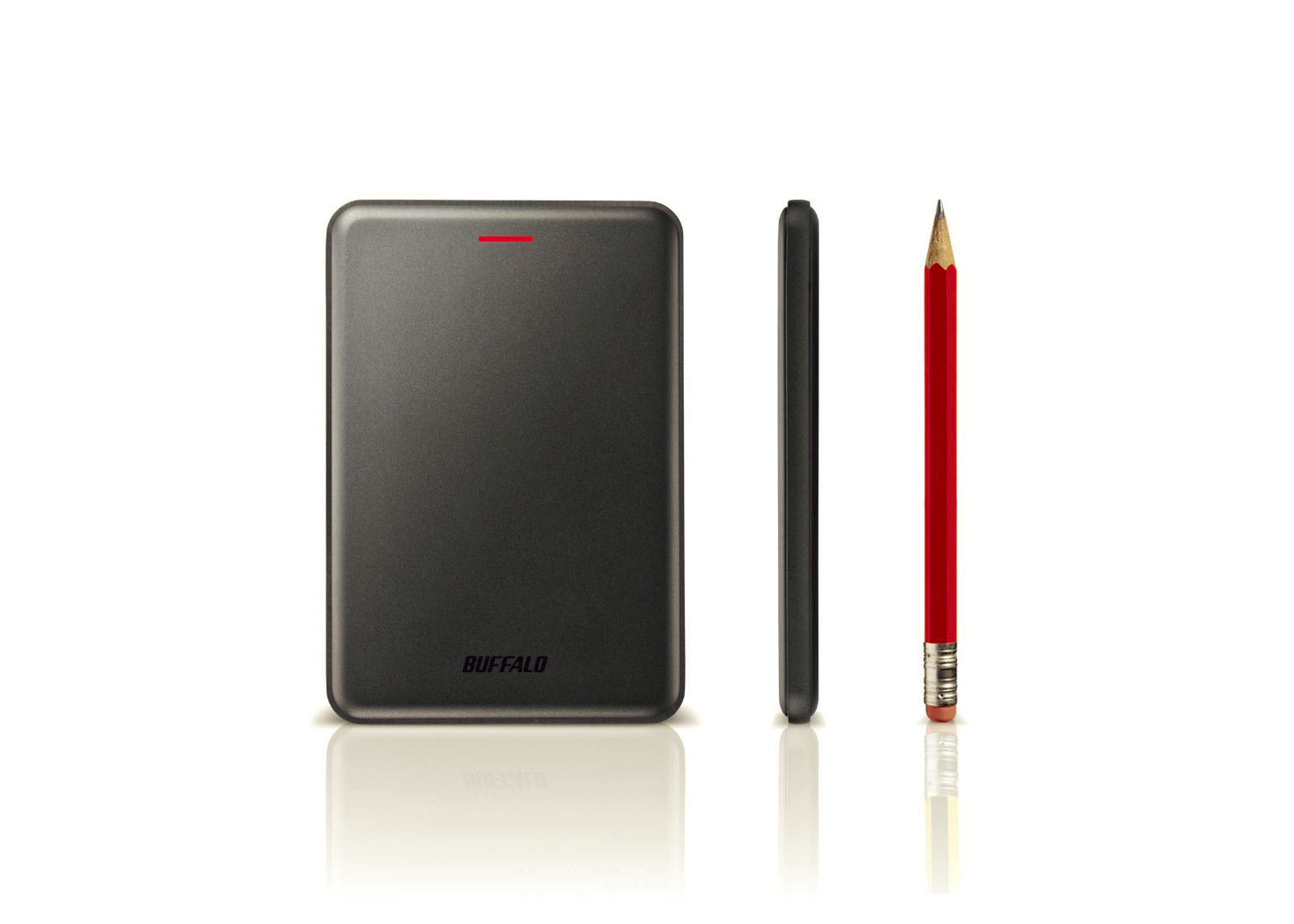External Storage News Roundup: Seagate, Plextor, ADATA, And Buffalo
Storage news is fun but unpredictable. Some weeks go with nary an announcement, and then the following week we are overrun. This week falls into the latter category, and for some nebulous reason, all of the announcements are of the external storage variety. Let's run through them quickly.
Seagate 5TB Backup Portable Plus HDD
Seagate announced the "world's largest"-capacity mobile drive. This is a true statement for a mobile drive, but there are larger external drives available, such as Seagate's own 8TB Backup Plus. (It requires a secondary power source, so it doesn't count as mobile.) We've also had Seagate's bus-powered Innov8 8TB HDD on the test bench, and because it doesn't require a secondary power source, you could consider it a quasi-mobile device, but its internal 3.5" drive would make that a bit of a stretch for most. It also has limited connectivity options.
The Backup Plus Portable 5TB drive features an internal 2.5" drive, so it could slip into your pocket, which neither of the aforementioned drives can pull off. The enclosure houses a 5TB BarraCuda 2.5" HDD that Seagate recently announced. Contrary to our original reporting, the 5TB BarraCuda is actually an SMR (Shingled Magnetic Recording) drive, which Seagate lists as perpendicular recording technology in the device manual.
The mention of perpendicular recording technology would lead one to surmise that it is the faster and more desirable PMR (Perpendicular Magnetic Recording). Seagate explained that the drive technically has both perpendicular recording technology and SMR, but it neglected to add the SMR tag to the specifications or manual. In either case, it's misleading. Seagate intends to correct the manual. SMR is much slower than PMR and features severe performance penalties with random data, so this drive isn't for performance.
Random performance shouldn't matter for an external product geared for backup roles, which are sequential in nature. The drive spins at 5,400 RPM and has a low startup power consumption that allows it to serve as an external drive with a USB 2.0 connection, though the Backup Plus also supports USB 3.0.
In keeping with most external products, there are no speeds and feeds listed, but the bare drive provides up to 140MB/s of throughput. The drive comes with Seagate's Dashboard backup software, USB cable, and 200GB of OneDrive storage for two years. The OneDrive storage is a nice addition, but the 5TB Backup Plus weighs in on the expensive side with an MSRP of $189.99. Seagate originally quoted a low price of $85 for the 5TB 2.5" BarraCuda; so low in fact, that we verified the price with the company. We still can't find the bare drive at retail in the U.S., but the MSRP for the Backup Plus suggests the original price quote might be incorrect. The Backup Plus comes in a rainbow of red, blue, silver, or black color options. It is available this month worldwide with a two-year warranty.
ADATA SD700 External SSD
ADATA's SD700 is kicking external storage up a notch with its 440MB/s of sequential read/write throughput over the USB 3.1 Gen 1 connection. The SD700 uses an unspecified type of 3D TLC NAND, but we know that currently the only 3D NAND floating around at third-party SSD manufacturers is of the IMFT TLC variety. The SSD comes in 256GB, 512GB, and 1TB capacities.
Get Tom's Hardware's best news and in-depth reviews, straight to your inbox.
The SD700 features a design that is reminiscent of the SanDisk Extreme 500 we've tested, but ADATA claimed its SD700 is 10/40 (read/write) MB/s faster. The SD700 is IP68-compliant, which means it is dustproof and waterproof according to the requirements of that specification, and it also adheres to the strenuous US Army MIL-STD-810G516.6 shock and drop resistance standard.
In other words, the brightly colored SSD takes a lickin' and keeps on tickin', which is a great example of just why SSDs are great for external storage.
The SD700 is very light at 100g and comes in either two-tone black and yellow, or all black. ADATA said it will debut at competitive price points, but we have yet to find it at retail.
Plextor EX1 External SSD
The external SSD hits keep on coming, but the Plextor EX1 differs from some competing options because of its slim design. A few other third-party SSD vendors offer a similar form factor, and we've seen a few similar prototypes from NAND fabs, so we expect this svelte form factor to continue to gain steam.
The concept is rather simple: slap an M.2 SSD into a slim external enclosure, add an internal adapter, and off you go. The device measures 3.98 x 1.24 x 0.34 inches, which lends itself well to mobility. The SSDs I've handled fit nicely in my pocket next to my smartphone (just sayin').
The EX1 offers USB 3.1 Gen 2 Type-C connectivity, and Plextor claimed it offers great external speed at 550/500 MB/s of read/write throughput. The SSDs come in gold and titanium silver and include a Type-C to Type-A USB adapter cable, flannel carrying pouch, and AES-256 encryption software. The EX1 is also compatible with Android devices. The drive features the typical shock-resistance and other advantages of SSDs and comes in 128GB, 256GB, and 512GB flavors. The EX1 will come to market in November with a five-year warranty (take that, external HDDs), but Plextor hasn't listed pricing at this time.
Buffalo MiniStation SSD and MiniStation Velocity SSD
Buffalo joined the external SSD party with its MiniStation SSD and MiniStation Velocity SSDs, which weigh in at a mere 30g. Buffalo claimed the vanilla USB 3.1 Gen 1 MiniStation SSD provides 420/370 MB/s of sequential read/write throughput, and it comes in 120GB, 240GB, and 480GB capacities. The drive supports software encryption and comes with a USB 3.0 cable. The 120GB drive is available for $92 USD, but no other prices were provided.
The faster USB 3.1 Gen 2 Velocity model boosts up to 500/480 MB/s, but it comes in only 240GB and 480GB capacities. It includes both USB Type A and Type C cables. The Velocity series starts at $160 for the 240GB model, but Buffalo does not list the 480GB's price.

Paul Alcorn is the Editor-in-Chief for Tom's Hardware US. He also writes news and reviews on CPUs, storage, and enterprise hardware.
-
JackNaylorPE I just don't see the appeal of these thingsReply
I'd rather use a USB 3 BlacX which allows one to just use a plain ole SATA SSD or HD and pop them in and out. Now I can use much cheaper standard SSD / SSHD / HD offerings and cycle them or keep multiple drives using same dock. Keep a system image on a spare storage device and a workstation w/ a failed storage device can be back up and running in 90 seconds. Could work like an optical drive. Press into place initiates a back up or copy function ... whatever ... drive pops out a half inch when done.
But perhaps the better question is, tho bit off topic is ...why aren't docking stations built into cases ? Why do I need another "thingy" taking up desk space and eating USB ports ?
Antec was the 1st that I seen with if I am recalling the model number correctly, the D-85 case which has 2.5" Hot Swap drive bay built in. Had a 2.5" HD in our video and photo cameras ... now that was convenient. Thermaltake has a few offerings like this.
http://www.thermaltake.com/products-model.aspx?id=C_00001627
Would love a case where the old 5.25" bay area could be used for various options could be purchased to:
a) LCD displaying system monitoring PC functions, temps / fan speeds or even the "big game" via streaming
b) Hot Swap HD bays ... yeay with SATA speeds. Run a backup at 4 pm and take the drive offsite when ya leave at 5. Insert on home machine and copy to HD just by inserting it.
c) OC Station like Asus put in those bays
d) Bay Reservoir / Pump combo -
ammaross Reply18881838 said:Would love a case where the old 5.25" bay area could be used for various options could be purchased to:
a) LCD displaying system monitoring PC functions, temps / fan speeds or even the "big game" via streaming
b) Hot Swap HD bays ... yeay with SATA speeds. Run a backup at 4 pm and take the drive offsite when ya leave at 5. Insert on home machine and copy to HD just by inserting it.
c) OC Station like Asus put in those bays
d) Bay Reservoir / Pump combo
My computer has an multimedia card reader with USB ports, a dual 2.5" SATA hot-swap dock, and a single 3.5"/2.5" hot-swap dock, and a DVD drive in the 4 5.25" drive bays in my case. Had to get a full tower to get 4x5.25" bays, but it was worth it. :) -
wifiburger mostly garbage, I'll read those storage news articles when all mechanical drives are no longer manufacturedReply





